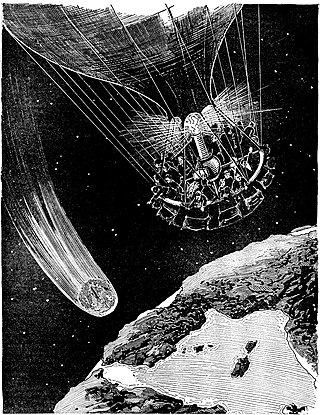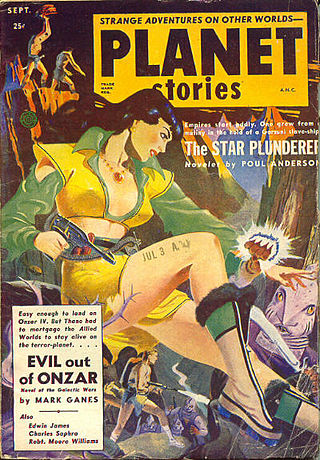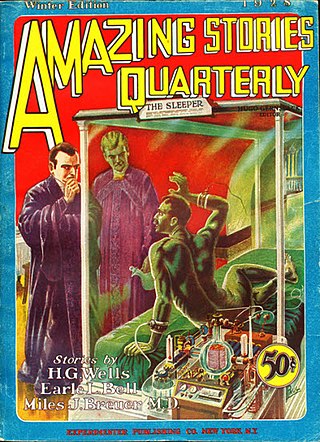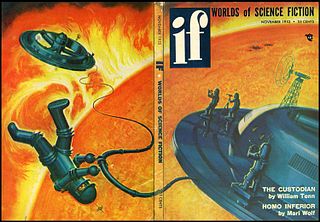
Mars, the fourth planet from the Sun, has appeared as a setting in works of fiction since at least the mid-1600s. Trends in the planet's portrayal have largely been influenced by advances in planetary science. It became the most popular celestial object in fiction in the late 1800s, when it became clear that there was no life on the Moon. The predominant genre depicting Mars at the time was utopian fiction. Around the same time, the mistaken belief that there are canals on Mars emerged and made its way into fiction, popularized by Percival Lowell's speculations of an ancient civilization having constructed them. The War of the Worlds, H. G. Wells's novel about an alien invasion of Earth by sinister Martians, was published in 1897 and went on to have a major influence on the science fiction genre.

The planet Venus has been used as a setting in fiction since before the 19th century. Its opaque cloud cover gave science fiction writers free rein to speculate on conditions at its surface—a "cosmic Rorschach test", in the words of science fiction author Stephen L. Gillett. The planet was often depicted as warmer than Earth but still habitable by humans. Depictions of Venus as a lush, verdant paradise, an oceanic planet, or fetid swampland, often inhabited by dinosaur-like beasts or other monsters, became common in early pulp science fiction, particularly between the 1930s and 1950s. Some other stories portrayed it as a desert, or invented more exotic settings. The absence of a common vision resulted in Venus not developing a coherent fictional mythology, in contrast to the image of Mars in fiction.

"Strange Eden" is a science fiction short story by American writer Philip K. Dick. It was first published in Imagination magazine during 1954, found under Second Variety and Other Classic Stories by Philip K. Dick in pp. 111–121.

Jupiter, the largest planet in the Solar System, has appeared in works of fiction across several centuries. The way the planet has been depicted has evolved as more has become known about its composition; it was initially portrayed as being entirely solid, later as having a high-pressure atmosphere with a solid surface underneath, and finally as being entirely gaseous. It was a popular setting during the pulp era of science fiction. Life on the planet has variously been depicted as identical to humans, larger versions of humans, and non-human. Non-human life on Jupiter has been portrayed as primitive in some works and more advanced than humans in others.

Saturn has made appearances in fiction since the 1752 novel Micromégas by Voltaire. In the earliest depictions, it was portrayed as having a solid surface rather than its actual gaseous composition. In many of these works, the planet is inhabited by aliens that are usually portrayed as being more advanced than humans. In modern science fiction, the Saturnian atmosphere sometimes hosts floating settlements. The planet is occasionally visited by humans and its rings are sometimes mined for resources.

Pluto has appeared in fiction as a setting since shortly after its 1930 discovery, albeit infrequently. It was initially comparatively popular as it was newly discovered and thought to be the outermost object of the Solar System and made more fictional appearances than either Uranus or Neptune, though still far fewer than other planets. Alien life, sometimes intelligent life and occasionally an entire ecosphere, is a common motif in fictional depictions of Pluto. Human settlement appears only sporadically, but it is often either the starting or finishing point for a tour of the Solar System. It has variously been depicted as an originally extrasolar planet, the remnants of a destroyed planet, or entirely artificial. Its moon Charon has also appeared in a handful of works.

Asteroids have appeared in fiction since at least the late 1800s, the first one—Ceres—having been discovered in 1801. They were initially only used infrequently as writers preferred the planets as settings. The once-popular Phaëton hypothesis, which states that the asteroid belt consists of the remnants of the former fifth planet that existed in an orbit between Mars and Jupiter before somehow being destroyed, has been a recurring theme with various explanations for the planet's destruction proposed. This hypothetical former planet is in science fiction often called "Bodia" in reference to Johann Elert Bode, for whom the since-discredited Titius–Bode law that predicts the planet's existence is named.

Neptune has appeared in fiction since shortly after its 1846 discovery, albeit infrequently. It initially made appearances indirectly—e.g. through its inhabitants—rather than as a setting. The earliest stories set on Neptune itself portrayed it as a rocky planet rather than as having its actual gaseous composition; later works rectified this error. Extraterrestrial life on Neptune is uncommon in fiction, though the exceptions have ranged from humanoids to gaseous lifeforms. Neptune's largest moon Triton has also appeared in fiction, especially in the late 20th century onwards.

Uranus has been used as a setting in works of fiction since shortly after its 1781 discovery, albeit infrequently. The earliest depictions portrayed it as having a solid surface, whereas later stories portrayed it more accurately as a gaseous planet. Its moons have also appeared in a handful of works. Both the planet and its moons have experienced a slight trend of increased representation in fiction over time.
The fictional portrayal of the Solar System has often included planets, moons, and other celestial objects which do not actually exist. Some of these objects were, at one time, seriously considered as hypothetical planets which were either thought to have been observed, or were hypothesized to be orbiting the Sun in order to explain certain celestial phenomena. Often such objects continued to be used in literature long after the hypotheses upon which they were based had been abandoned.
"Not by Its Cover" is a science fiction short story by American writer Philip K. Dick, a "loose sequel" to his first published science fiction short story, "Beyond Lies the Wub". The story continues the former's theme of immortality, although not focusing on a living Wub itself, but rather its fur.

Beyond Lies the Wub is a collection of science fiction stories by American writer Philip K. Dick. It was first published by Gollancz in 1988 and later comprised Volume I of The Collected Stories of Philip K. Dick. Many of the stories had originally appeared in the magazines Fantasy and Science Fiction, Planet Stories, If, Galaxy Science Fiction, Imagination, Space Science Fiction, Fantastic Story Magazine, Amazing Stories, Future, Cosmos, Fantasy Fiction, Beyond Fantasy Fiction, Thrilling Wonder Stories, Startling Stories. The collection was reprinted by Citadel Press in 2003 under the title Paycheck and Other Classic Stories.

The Short Happy Life of the Brown Oxford is a collection of science fiction stories by American writer Philip K. Dick. It was first published by Citadel Twilight in 1990 and reprints Volume I of The Collected Stories of Philip K. Dick. Many of the stories had originally appeared in the magazines Fantasy and Science Fiction, Planet Stories, If, Galaxy Science Fiction, Imagination, Space Science Fiction, Fantastic Story Magazine, Amazing Stories, Future, Cosmos, Fantasy Fiction, Beyond Fantasy Fiction, Thrilling Wonder Stories and Startling Stories. The collection was reprinted by Citadel Press in 2003 under the title Paycheck and Other Classic Stories.

Comets have appeared in works of fiction since at least the 1830s. They primarily appear in science fiction as literal objects, but also make occasional symbolical appearances in other genres. In keeping with their traditional cultural associations as omens, they often threaten destruction to Earth. This commonly comes in the form of looming impact events, and occasionally through more novel means such as affecting Earth's atmosphere in different ways. In other stories, humans seek out and visit comets for purposes of research or resource extraction. Comets are inhabited by various forms of life ranging from microbes to vampires in different depictions, and are themselves living beings in some stories.
"Meddler" is a science fiction short story by American writer Philip K. Dick. It was first published in Future Science Fiction, October 1954 with illustration by Virgil Finlay. Dick had submitted many short stories to magazines and made approximately fifteen sales before becoming a client of the Scott Meredith Literary Agency. This was his second SMLA submission, received by SMLA on July 24, 1952. His first SMLA submission was The Builder, received by SMLA on July 23, 1952.

"The Gun" is a science fiction short story by American writer Philip K. Dick, first published in 1952 September issue of Planet Stories, and later published in Beyond Lies the Wub in 1984. "The Gun" has been published in Italian, German, French and Polish translations.

"Mr. Spaceship" is a science fiction short story by American writer Philip K. Dick, first published in Imagination in January 1953, and later in The Collected Stories of Philip K. Dick. It has since been republished several times, including in Beyond Lies the Wub in 1988.
"The Infinites" is a science fiction short story by American writer Philip K. Dick, first published in 1953 in the May issue of Planet Stories. It has since been republished several times, including in Beyond Lies the Wub in 1988 and in The Collected Stories of Philip K. Dick.

Amazing Stories Quarterly was a U.S. science fiction pulp magazine that was published between 1928 and 1934. It was launched by Hugo Gernsback as a companion to his Amazing Stories, the first science fiction magazine, which had begun publishing in April 1926. Amazing Stories had been successful enough for Gernsback to try a single issue of an Amazing Stories Annual in 1927, which had sold well, and he decided to follow it up with a quarterly magazine. The first issue of Amazing Stories Quarterly was dated Winter 1928 and carried a reprint of the 1899 version of H.G. Wells' When the Sleeper Wakes. Gernsback's policy of running a novel in each issue was popular with his readership, though the choice of Wells' novel was less so. Over the next five issues, only one more reprint appeared: Gernsback's own novel Ralph 124C 41+, in the Winter 1929 issue. Gernsback went bankrupt in early 1929, and lost control of both Amazing Stories and Amazing Stories Quarterly; associate editor T. O'Conor Sloane then took over as editor. The magazine began to run into financial difficulties in 1932, and the schedule became irregular; the last issue was dated Fall 1934.

The Sun has appeared as a setting in fiction at least since classical antiquity, but for a long time it received relatively sporadic attention. Many of the early depictions viewed it as an essentially Earth-like and thus potentially habitable body—a once-common belief about celestial objects in general known as the plurality of worlds—and depicted various kinds of solar inhabitants. As more became known about the Sun through advances in astronomy, in particular its temperature, solar inhabitants fell out of favour save for the occasional more exotic alien lifeforms. Instead, many stories focused on the eventual death of the Sun and the havoc it would wreak upon life on Earth. Before it was understood that the Sun is powered by nuclear fusion, the prevailing assumption among writers was that combustion was the source of its heat and light, and it was expected to run out of fuel relatively soon. Even after the true source of the Sun's energy was discovered in the 1920s, the dimming or extinction of the Sun remained a recurring theme in disaster stories, with occasional attempts at averting disaster by reigniting the Sun. Another common way for the Sun to cause destruction is by exploding, and other mechanisms such as solar flares also appear on occasion.
















